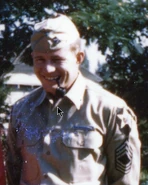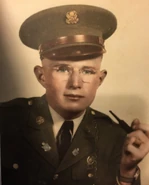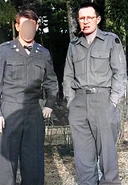James Lee Quong was a United States Army soldier who went missing in action during the Korean War on December 2, 1950. On July 27, 2018, his remains were returned to the United States and identified on June 18, 2020.
Biography[]
James Quong was born on October 13, 1920, in Fort Worth, Texas, to Jim Lee and Flora Robbins (or Robinson). At some point, Jim and Flora presumably divorced, and Flora married Lee Bing Quong, who immigrated from China in 1908. The family would move to Norman, Oklahoma, where James grew up with a sister named Margaret. His friends and family would describe him as a "red-headed Scot, American born" who loved to play the bagpipes.
When he was 16, James joined the National Guard. By 1940, he was living with his father and had briefly attended the University of Oklahoma. During World War II, he was an Army Reserve captain. In 1942, he married Jennie Lou Grey in Cleveland, Oklahoma, and the two had three children, Terrence, Marilyn, and Suzanne.
Before enlisting in the United States Army in 1946, James lived in Oklahoma City and worked as a metal worker. He rose through the ranks and became a Master Sergeant.
In around 1948, James and his family moved to Camp Haugen, Japan. In 1949, the Korean War began, and so he was deployed to the Korean War peninsula as a member of Company D, 1st Battalion, 32nd Infantry Regiment, 7th Infantry Division.
The 7th Infantry Division took part in the Battle of Inchon, AKA the Inchon Landing, between September 10 and September 19, 1950. Inchon was invaded and taken over by forces from the United States and South Korea. This battle was a strategic victory for the United Nations Command that turned the tide of the war in their favor. James likely participated in this battle, but details of his participation are unknown.
James' unit took part in the Battle of Chosin Reservoir. Between November 27 and December 13, 1950, the North Korean People's Army and the Chinese People's Volunteer Army recovered northeastern Korea and caused the UNC to retreat. In the ensuing chaos, James was reported as missing in action on December 2, 1950. Over 17,000 United Nations soldiers were killed, wounded, or missing, and between 49,000 and 60,000 Chinese soldiers were killed or wounded.
Aftermath[]
James was not among the prisoners of war or identified remains recovered when the Korean War ended on July 27, 1953. He was declared dead on December 31, 1953. His disappearance and presumed death made his children's childhood challenging.
James was posthumously awarded the following awards: Purple Heart, Combat Infantryman's Badge, Korean Service Medal, United Nations Service Medal, National Defense Service Medal, Korean Presidential Unit Citation, and Republic of Korea War Service Medal. Additionally, he was memorialized in Court 6 of the Honolulu Memorial Courts of the Missing in Honolulu, Hawaii and the National Korean War Veterans Memorial in Washington, D.C.
Identification[]
On July 27, 2018, following a US and North Korea joint-summit between President Donald Trump and Supreme Leader Kim Jong-un the month before, the North Korean government returned 55 boxes of unknown US soldiers to US custody. They arrived at Joint Base Pearl Harbor-Hickam, Hawaii on August 1, 2018. Scientists at the Defense POW/MIA Accounting Agency used mitochondrial DNA (mtDNA), Y-chromosome DNA (Y-STR), and autosomal DNA (auSTR) analysis to identify the remains.
Based on these DNA analysis techniques and historical evidence, James Lee Quong's remains were identified on June 18, 2020. The identification was announced on December 2, 2021. By the time of his identification, his parents, stepfather, wife, and two of his children had already passed away. He will be buried at the Arlington National Cemetery in Arlington, Virginia. The date has yet to be determined.
Gallery[]
Sources[]
- Defense POW/MIA Accounting Agency
- James Quong (Honolulu Memorial) at Find a Grave
- James Quong (National Korean War Veterans Memorial) at Find a Grave
- Battle of Chosin Reservoir on Wikipedia


